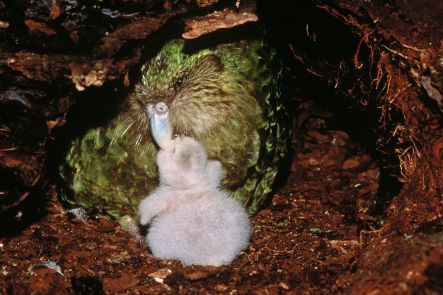
Female kakapo Alice feeds her 12-day-old chick. Image courtesy of Don Merton/Department of Conservation
It's summer and the world's 90 remaining kakapo have breeding on their mind. The Department of Conservation's Kakapo Recovery Team is optimistic that this could be an outstanding kakapo breeding season on Codfish Island-Whenua Hou, and with the first mating of the season taking place on the night of Christmas Day, their optimism appears well-founded.
Kakapo are the world's heaviest parrots. They are flightless, nocturnal vegetarians, and are unique to New Zealand. Once widespread throughout the main islands of New Zealand, their numbers declined following the arrival of humans, the clearance of much of their forest home and the introduction of mammalian predators such as stoats, cats and rats. By the 1950s they were feared extinct, until a remnant population of a few males were rediscovered in Fiordland. In the late 1970s a breeding population of several hundred birds was rediscovered on Stewart Island, but when this was threatened by feral cats the entire population was captured and relocated to safe offshore islands, including Little Barrier Island and Codfish Island-Whenua Hou.
To find out more about kakapo, have a look at the Kakapo Recovery Programme and the Department of Conservation's kakapo page.
In this programme, Kakapo Recovery Programme managers Deidre Vercoe and Daryl Eason talk about what they are expecting this year and how they might deal with hand-rearing up to 60 chicks. Over the coming weeks we will explore how intermittent mass rimu fruiting triggers irregular kakapo breeding, kakapo genetics, the implications of low genetic diversity and inbreeding, and artificial insemination as a way of increasing the number of rare Fiordland genes in the kakapo population.

